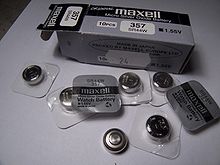Silver oxide zinc battery
Silver oxide zinc cells (abbreviated: “silver oxide cells”) are primary cells . They are mainly sold in the form of button cells and then bear the IEC designation " SR ".
The negative pole (anode) of a silver oxide-zinc cell consists of zinc powder , which is oxidized in the course of the discharge . The positive pole (cathode) consists of silver (I) oxide , which is reduced to elemental silver when discharged . Diluted potassium hydroxide (or sodium hydroxide ) is used as the electrolyte . The nominal voltage of such a cell is about 1.55 V. In addition to zinc hydroxide, potassium zincate (K 2 [Zn (OH) 4 ]) is also formed through reaction with the electrolyte .
Traditional silver oxide-zinc cells can only be recharged a few tens of times. However, there are hundreds of rechargeable silver-zinc batteries from ZPower with an energy density of 338 or 272 Wh / l (depending on size).
Chemical processes
In simplified terms, the following reactions take place during discharge:
- Reduction:
- Oxidation:
- Redox:
- Total:
swell
- ^ Paul Buckley: Opinion: Recharge your engineering batteries. EDN Network, August 25, 2008, accessed on December 12, 2017 (English): "Silver-zinc technology ['s] ... traditional short cycle life of about 20 to 25 recharge cycles has hampered its application in the consumer market."
- ↑ a b ZPower Size 312 Rechargeable Battery (XR41) (data sheet)
- ↑ ZPower Silver-Zinc Rechargeable Microbatteries
- ↑ ZPower Size 13 Rechargeable Battery (XR48) (data sheet)





